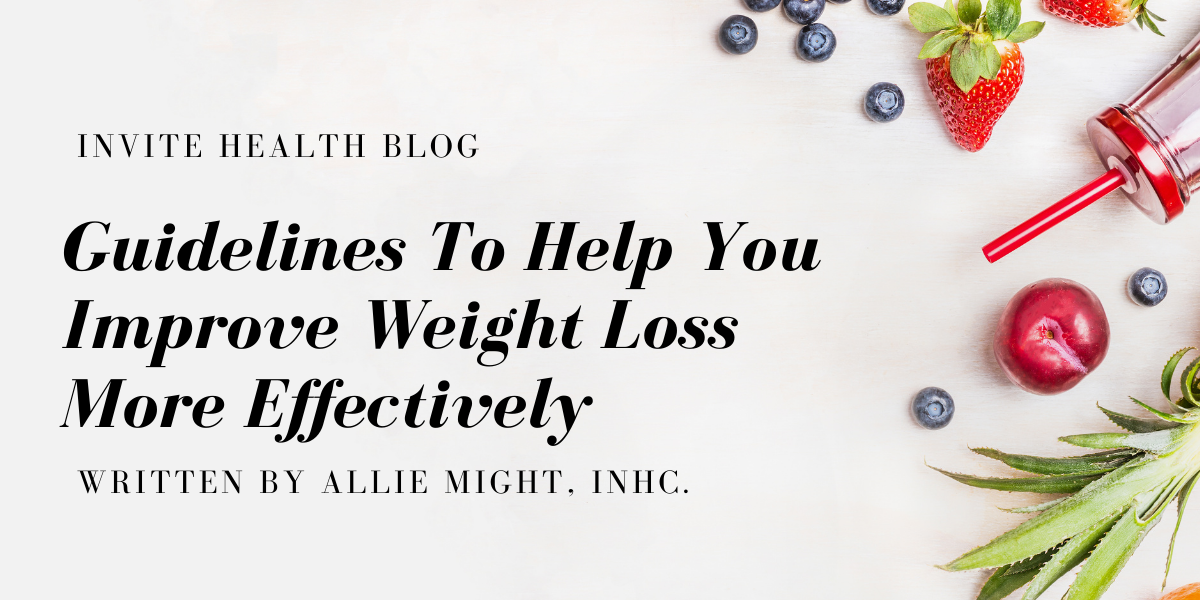Guidelines To Help You Improve Weight Loss More Effectively

weight loss
Written by Allie Might, INHC
For further questions or concerns email me at amight@invitehealth.com
There’s a lot of diet programs out there. From Keto to Intermittent Fasting; Vegan to Vegetarian, and the newest Weight Loss programs. “Do these actually work or are they the latest ‘fad diets?’ “How do I know which diet is right for me?” I hear these questions every day.†
“Fad” Diet Breakdown
The Ketogenic, or Keto, diet is a low carb/high fat way of eating. It’s often recommended to support conditions such as diabetes, acne, heart disease and brain issues like epilepsy. But many people use this as a way of eating for weight loss. I have seen people make the mistake of indulging too much in bacon and cheese; leaving out the healthy fats like avocado and lean proteins such as boneless/skinless chicken breast, broiled fish or lean beef. Also, don’t forget your green vegetables such as spinach and broccoli with your proteins at meal time.†
Another diet, Intermittent Fasting, has had quite the chatter over the past few years. For this diet, you eat within a limited amount of time, then have designated fasting periods from 12 to 40 hours. While this can lead to weight loss, it’s extremely restrictive and potentially harmful; especially for people with underlying health issues. However, if you feel intermittent fasting could be right for you, please consult your doctor or health professional to make the right plan for you.†
Finally, the difference between vegetarian and vegan. Vegetarian eliminates the consumption of animals but still allows us to eat animal bi-products like milk, cheese, eggs and honey. A vegan diet one doesn’t eat any animal products or bi-products. On this diet, you stick to foods such as fruit, vegetables, whole grains, nuts, seeds, beans, legumes and tofu. Both these diets can be effective and can eventually become a lifestyle. However, it’s easy to eat things like pasta and potatoes, which are acceptable on these plans; but can cause weight gain instead of weight loss.†
FIXING NUTRIENT DEPLETIONS IN VEGAN DIETS – INVITE HEALTH PODCAST, EPISODE 222 >> Listen Now!
I tend to discourage weight loss membership programs. In my experience, they can be helpful to some, but so many gain back the lost weight. Many times, you are encouraged or required to purchase food programs exclusive to them. These programs can be highly processed and not nutrient dense.†
The Recommended Diet for Weight Loss
Choose My Place is run by the U.S. Food and Drug Administration (FDA). What does the FDA recommend for us to follow? This is the current guideline from the FDA. The updated My Plate map shows us how our meal plate should be divided. The FDA recommends incorporating more nutrient rich foods by making a couple of changes to our diet. Here’s my detailed examples of adjustments you can make to your current eating habits. †
Liquids should be consumed daily; that means drink water! You should be drinking half of your body weight in ounces everyday (i.e.: if you weigh 100 pounds, you would want to drink 50 ounces of water per day). You will want to avoid soda, juice, and energy drinks. †
Vegetables should be approximately 5-9 cups of vegetables and leafy greens every day. They should be eaten raw, steamed, lightly sautéed or roasted to obtain as much nutrients as possible. The best vegetables are the ones you like and can tolerate. However, I would strongly encourage you to try new options. Try avoiding frying, coating of bread crumbs or batters and cheese when preparing your vegetables. †
Fruits should be approximately 1-2 servings per day. A serving is generally a piece of fruit (i.e.: apples, bananas, oranges, etc.) or about 3/4 cup of melon, tropical fruit or berries. Though if you are pre-diabetic or diabetic, berries would be the best choice but limiting to only 1 serving a day. †
Grains and starches should be consumed in approximately 2 servings of about 1/2 cup per day. Whole grains are the best choice consisting of brown rice, wheat berries, millet, and amaranth. You can also try starches such as beans, lentils, squash, and sweet potatoes. †
Protein should be consumed daily with approximately 5 servings per day. Lean proteins such as fish, seafood, boneless/skinless chicken, turkey, eggs, tofu, and beef are the best choices. The best method of preparation would be to bake, lightly sauté, grill, or broil your proteins. Try to avoid frying, breading, or using heavy sauces on your proteins. †
Dairy should be consumed with approximately 2 servings per day. Always try to look for low fat options like plain Greek yogurt. Dairy milk alternatives such as soy, almond, coconut, rice, or oat milk may be a good option for some. Butter alternatives such as healthy olive oil, coconut oil, avocado oil, or banana oil can be used as well. †
Fats are important in our diet and we should be consuming about 2 servings per day. That can consist of about a 1/2 of avocado, a tablespoon of olive oil, grape seed oil, or avocado oil. †
It is important to be mindful when choosing a snack. Choose snacks consisting of fruit, a handful of raw nuts, or sliced vegetables sticks with hummus. We always want to try to avoid processed foods, artificial sweeteners, fast food items, and any products with high fructose corn syrup as much as possible. †
Here is a nice tropical summer shake that you can make to help you on your journey to weight loss!
TROPICAL SUMMER SHAKE
1 cup of water
1/2-1 cup of ice
½ cup of pineapple, fresh or frozen
1 T unsweetened coconut flakes, toasted
1 t raw organic extra virgin coconut oil
2 scoops Whey Protein Isolate Powder
1 scoop Collagen Hx
Put all ingredients in a blender and blend until smooth. Add a straw and enjoy!
Sources
https://www.myplate.gov/
https://www.myplate.gov/eat-healthy/what-is-myplate
https://www.medicalnewstoday.com/articles/323411#butter-alternatives
https://www.webmd.com/diet/ss/slideshow-ketogenic-diet
https://www.healthline.com/nutrition/6-ways-to-do-intermittent-fasting

